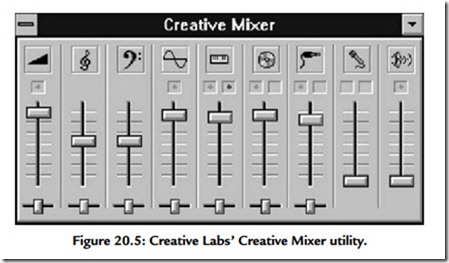Sound Cards
Available in a bewildering array of different guises, for serious audio work, 16-bit cards only are suitable, and even then beware of very poor noise levels. Computers differ widely in their suitability as devices for high-quality audio. The Creative Technology Ltd. Sound Blaster card family has some of the most widespread sound cards used in the PC world. Supplied standard with a four operator FM sound generator chip for sound synthesis, Creative Labs offer a wavetable-based upgrade. Sound Blaster ships with sound file editing software. The card comes with a utility program for controlling the analogue mixer on the card where the various sound sources are combined and routed. This utility is called Creative Mixer and it’s illustrated in Figure 20.5. Note that fader style controls are implemented in software so as to provide a familiar user interface. Control over CD, MIDI synthesizer, and WAV file replay, as well as line and microphone inputs, are provided. Global (all sources) equalization is also provided.
PCI Bus Versus ISA Bus
Most PCs, until the arrival of the Pentium, were provided with a PC/AT bus (or ISA bus) for connecting peripherals (such as sound cards, frame grabbers, and so on). The ISA bus operates with 16-bit data bus and a 16-bit address bus and operates with a divided clock. The ISA bus limits real-world transfer rates to around 1–2 Mbytes/s, which is just enough
for high-quality, dual-channel audio. The Peripheral Component Interconnect (PCI) bus is incorporated in newer Pentium-based IBM PCs. PCI is a local bus, so named because it is a bus which is much “closer” to the CPU. Local buses run at a much higher rate and PCI offers considerable performance advantages over the traditional ISA bus, allowing data to be transferred at between 5 and 70 Mbytes/s; allowing the possibility of real-time, multitrack audio applications. The PCI bus is a processor-independent bus specification that allows peripheral boards to access system memory directly (under the aegis of a local bus controller) without directly using the CPU, employing a 32-bit data bus and a 64-bit address bus at full clock speed. Installation and configuration of PCI bus plug-in cards are much simpler than the equivalent installation on the ISA bus. Commonly referred to as the “plug-and-play” feature of the PCI bus, this user transparency is achieved by having the PCs BIOS configure the plug-in card’s base address and interrupt level at power-up. Because all cards are automatically configured, conflicts between them are eliminated. It is a process that can only be done manually with cards on the ISA bus. The PCI Bus is not limited to PCs; it is the primary peripheral bus in the PowerPC and PowerMacs from Apple. Incorporation of the PCI bus is planned for other RISC-based processor platforms.
